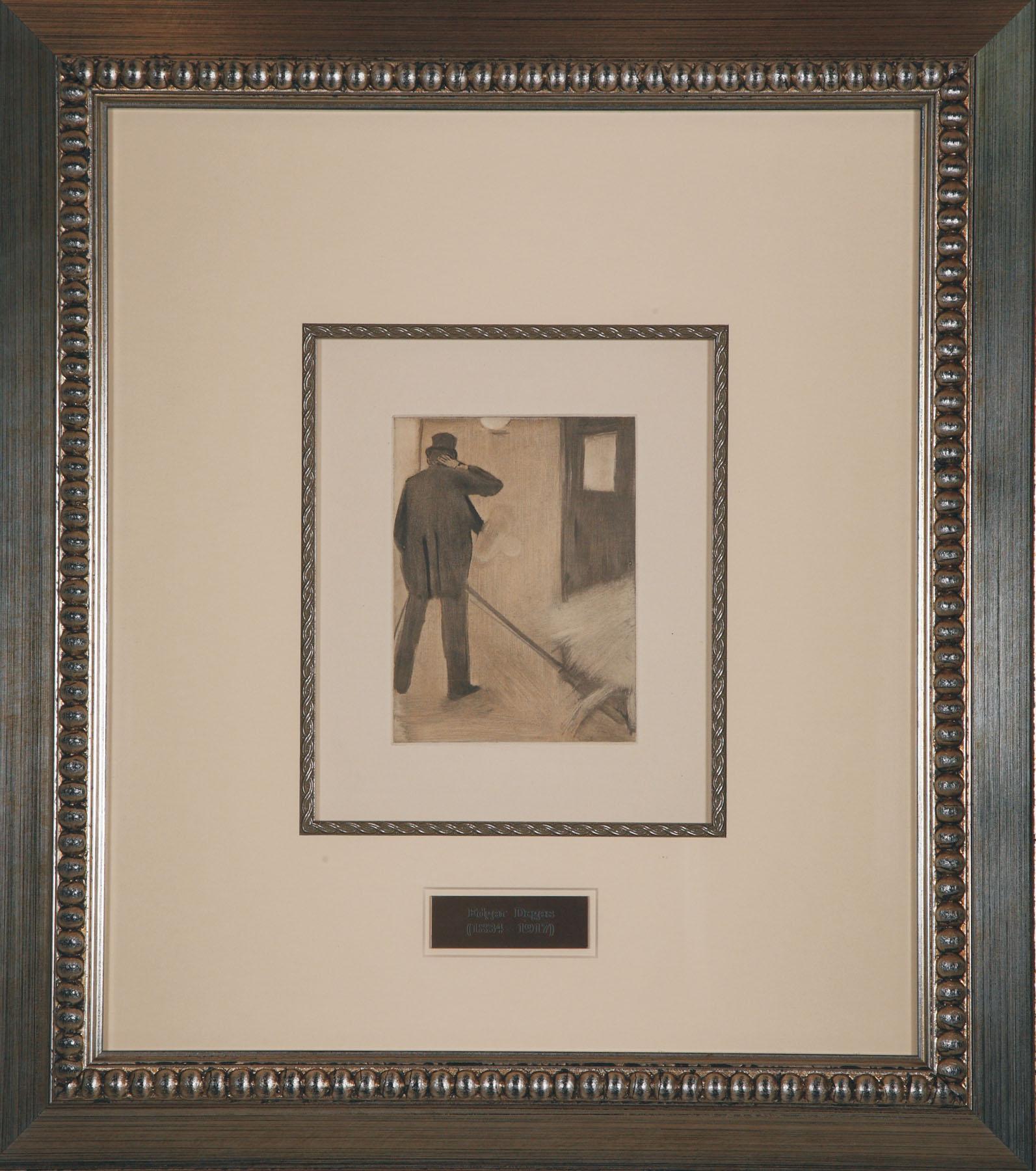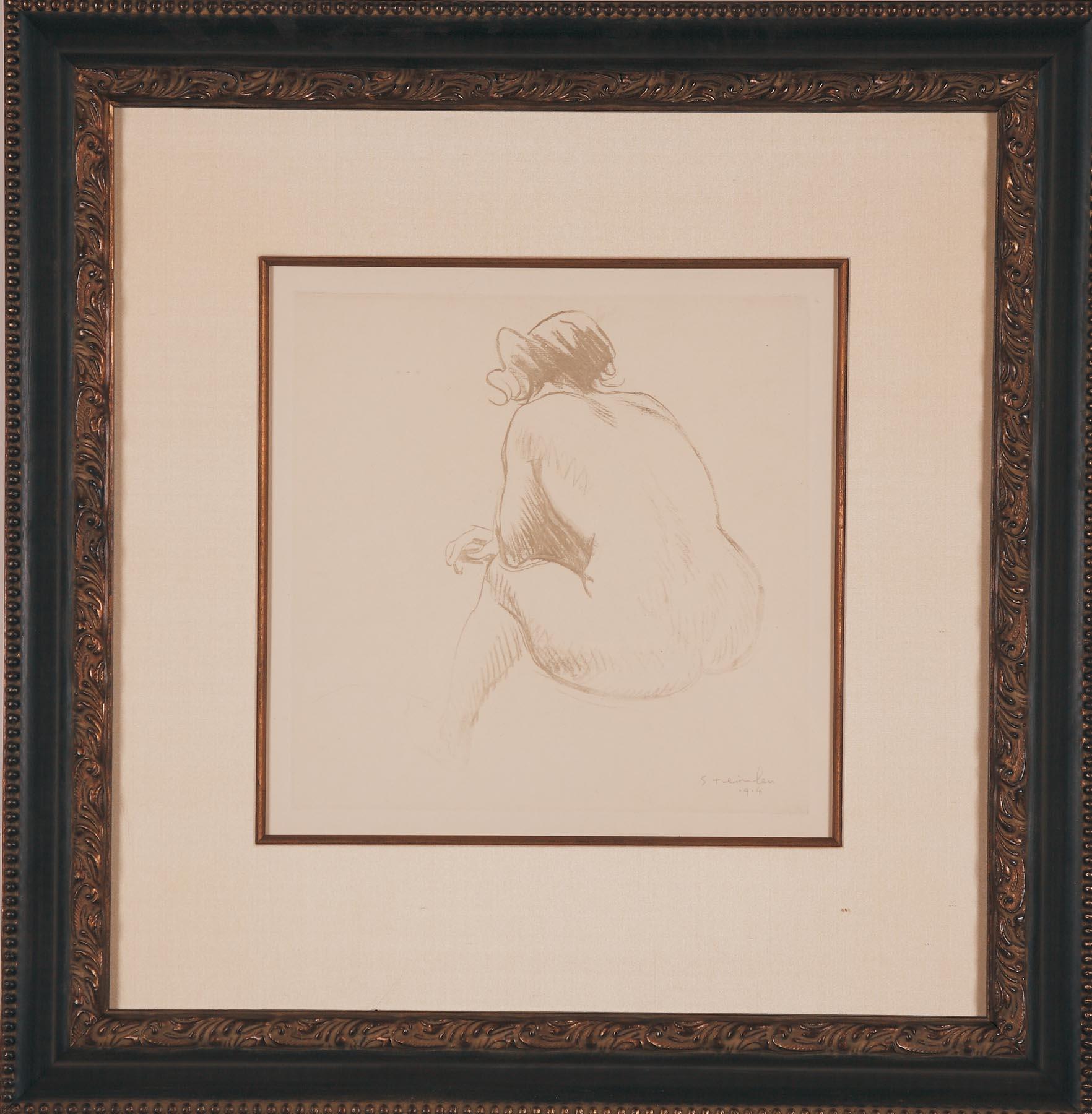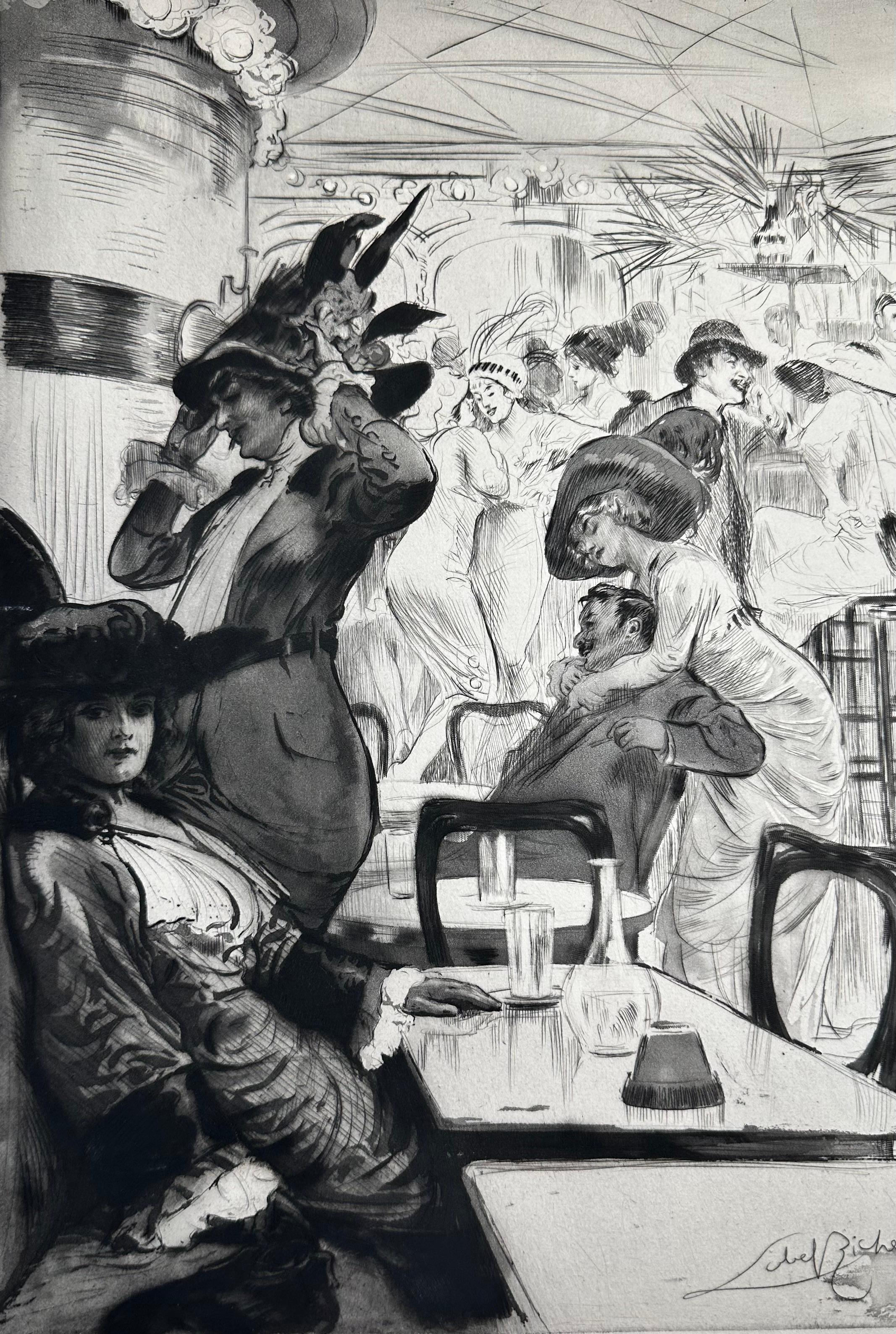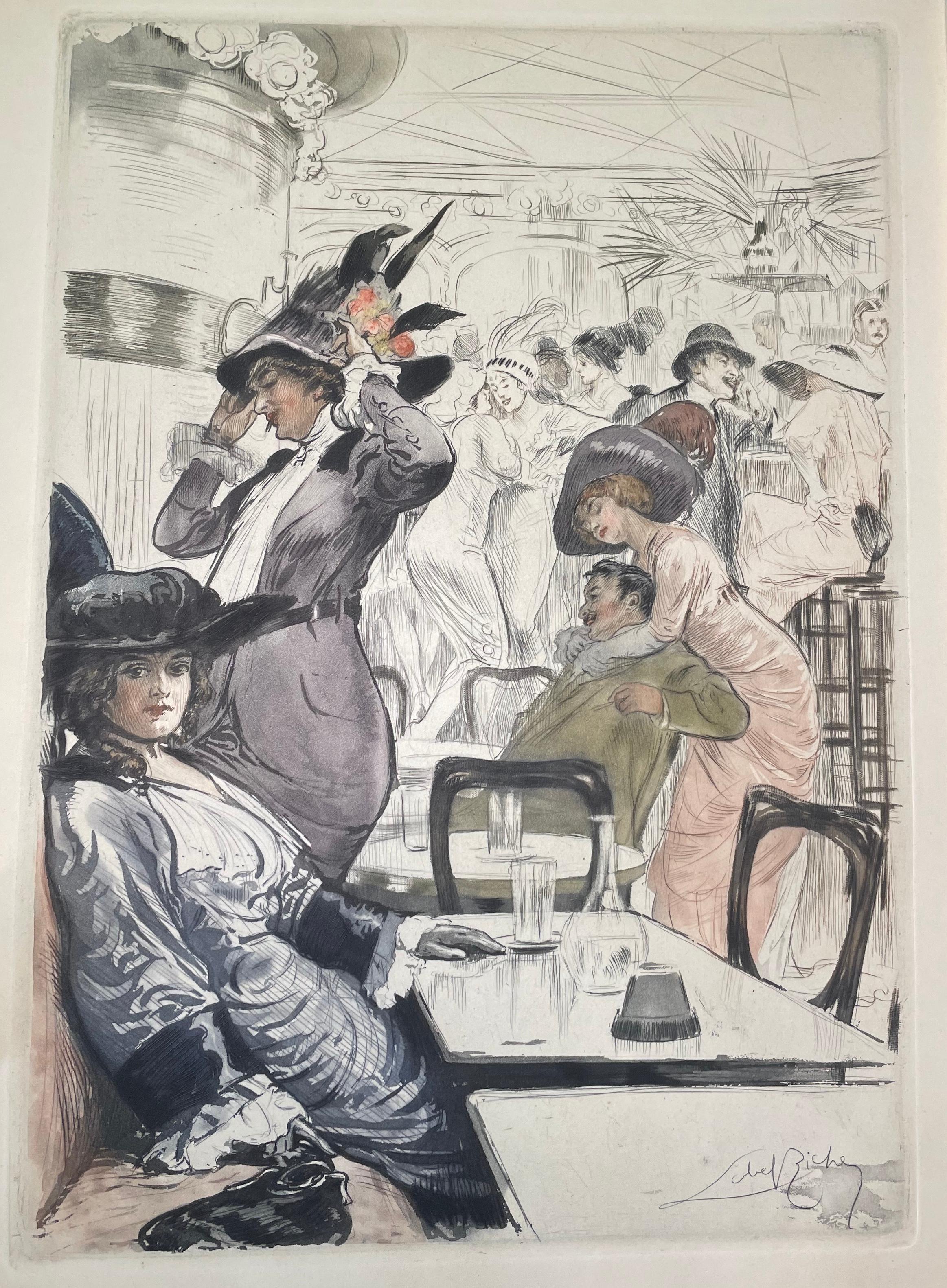Items Similar to "Ludovic Halevy Meeting Madame Cardinal Backstage" after Edgar Degas
Want more images or videos?
Request additional images or videos from the seller
1 of 7
"Ludovic Halevy Meeting Madame Cardinal Backstage" after Edgar Degas1938
1938
About the Item
Degas, Edgar (after)
(1834 -1917)
"Ludovic Halevy Meeting Madame Cardinal Backstage"
Soft-Ground Etching created from a Monotype, 1938-9
First State. # 251 from the edition of 350 on Velin de Rives paper
From La Famille Cardinal, page 17, published by Blaizot. ParisText written by Ludovic Halévy,
Etching created by Maurice Potin
Watermarks BFK Rives and Blaizot Editeur, Full Margins as issued
Sheet size: 9.75” x 12.75”, Plate Size: 6.25” x 8.25”
Fine strong impression with rich tone
Etchings from this suite are particularly important because many of the original monotypes from Edgar Degas have vanished. These etchings from this suite remain the only documentation of their existence! Edgar Degas created monotypes to illustrate La Famille Cardinal, Ludovic Halévy's collection of short stories documenting the backstage life of Pauline and Virginie Cardinal at the Paris Opera. In 1938, the monotypes were finally published by Blaizot as etching illustrations. These etchings, hand-pulled by Maurice Potin, have been documented by leading Degas scholars Adhemar and Cachin, E. P. Janis and Jean Boggs. The edition is limited to only 350 copies. The monotypes were created by Degas in 1880, but these legendary etchings were not published until 1938. Degas made the monotypes to illustrate Halévy’s book, La Famille Cardinal, a satire of social-climbing ballet dancers, controlling stage mothers and the backstage sex-trade. Hoping to illustrate a new edition of the book, originally published in 1872, Degas created a collection of monotypes inspired by the story in the early 1880s. Since Halévy narrated the book in the first person, Degas included him in nine of the illustrations. Theodore Reff suggests that Halévy did not publish his friends monotypes because, “On the whole, Degas’ illustrations are more a recreation of the spirit and ambience than authentic illustrations”. Edgar Degas was the Impressionist artist known as the observer of modern Paris life.
- Creation Year:1938
- Dimensions:Height: 13.25 in (33.66 cm)Width: 15.25 in (38.74 cm)Depth: 0.125 in (3.18 mm)
- More Editions & Sizes:Small editionPrice: $450
- Medium:
- Movement & Style:
- After:(after) Edgar Degas (1834 - 1917, French)
- Period:
- Condition:
- Gallery Location:Hinsdale, IL
- Reference Number:
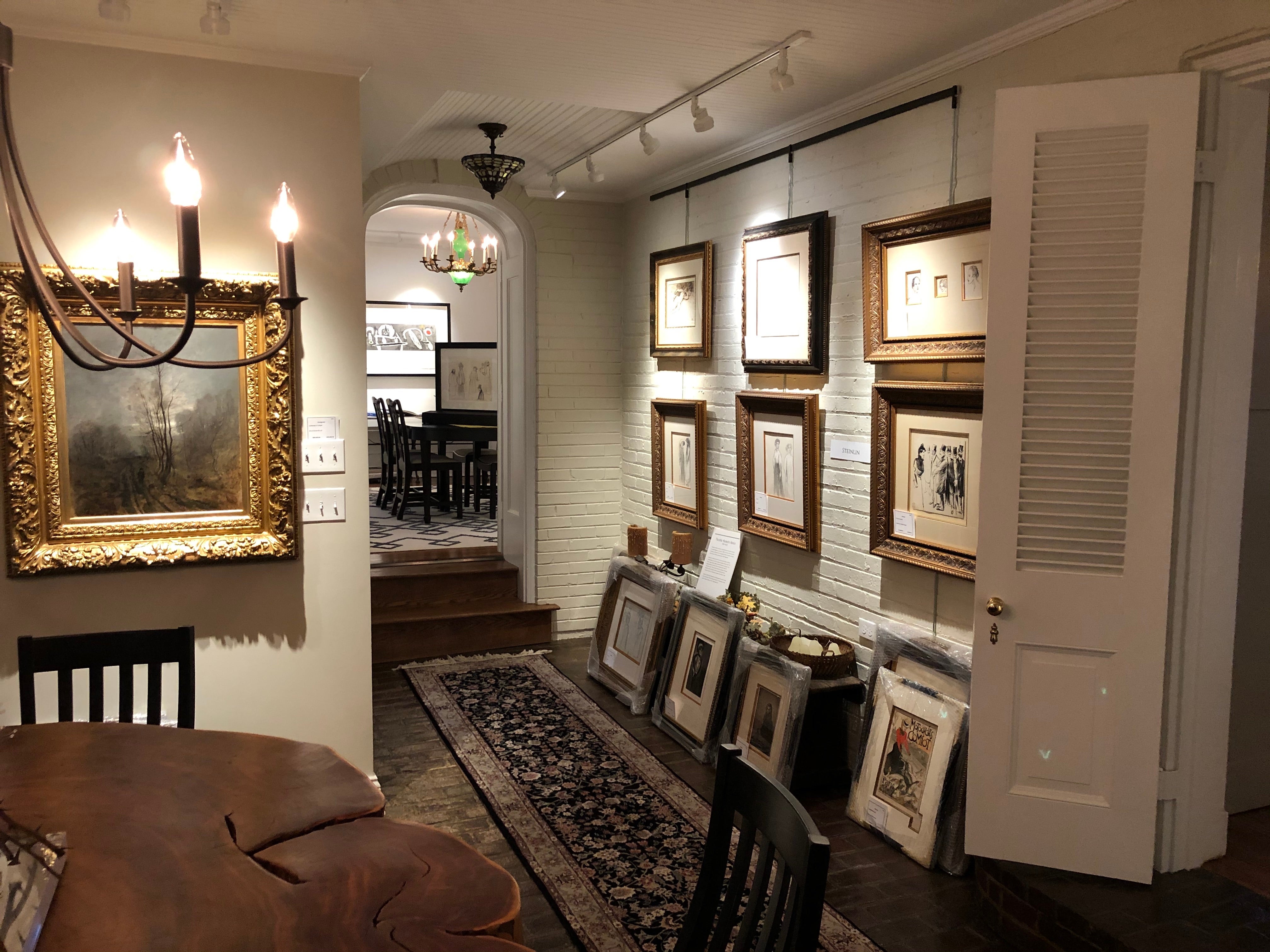
About the Seller
5.0
Vetted Seller
These experienced sellers undergo a comprehensive evaluation by our team of in-house experts.
Established in 1994
1stDibs seller since 2020
36 sales on 1stDibs
- ShippingRetrieving quote...Ships From: Hinsdale, IL
- Return PolicyA return for this item may be initiated within 14 days of delivery.
More From This SellerView All
- "Ludovic Halevy Backstage" from La Famille Cardinal after Edgar DegasBy (after) Edgar DegasLocated in Hinsdale, ILDegas, Edgar (after) (1834 -1917) "Ludovic Halevy Backstage" Monod 5797, Adhemar 71, Skira 58, Stern 25 Soft-Ground Etching created from a Monotype, 1938-9 First State. # 251 from ...Category
Early 20th Century Art Nouveau Figurative Prints
MaterialsEtching
- "Femme Nue" by SteinlenBy Théophile Alexandre SteinlenLocated in Hinsdale, ILSTEINLEN, THEOPHILE ALEXANDRE (1859 -1923) "FemmeNue" (A Nude Woman) Original etching, c. 1900 Signed and numbered in Pencil Provenance: From the atelier of the artist Image Size: ...Category
Early 20th Century Art Nouveau Figurative Prints
MaterialsEtching
- "Portrait of Madame Georges Menier" By HelleuBy Paul César HelleuLocated in Hinsdale, ILHELLEU, PAUL CÉSAR (1859 - 1927) MADAME GEORGES MENIER Montesquiou XXI Drypoint in colors, c. 1900 Signed in pencil, lower right Printed on wove paper Full Margins 22 1/4” x 13...Category
Early 19th Century Art Nouveau Figurative Prints
MaterialsDrypoint, Etching
- "Femme au Boa" etching by SteinlenBy Théophile Alexandre SteinlenLocated in Hinsdale, ILSTEINLEN, THEOPHILE ALEXANDRE (1859 -1923) "Femme au Boa" Crauzat 61 Etching, Drypoint and Aquatint, c. 1900 Signed in pencil, lower right From the edition of 13 total impressions Image Size: 8 5/8” x 5 ½” The Parisian woman of Paris...Category
Early 20th Century Art Nouveau Figurative Prints
MaterialsEtching
- "La Danse à la Campagne", 2nd plate by Pierre-Auguste RenoirBy Pierre-Auguste RenoirLocated in Hinsdale, ILRENOIR, PIERRE AUGUSTE (1841 -1919) "La Danse à la Campagne", 2nd plate (The Country Dance (second plate)) Delteil 2, Stella 2 Soft-ground Etching in black ink, c. 1890 Only State on smooth wove paper With the stamped signature, as issued Image Size: 8 5/8” x 5 1/3” Fine strong and tonal impression with full margins The most famous etching...Category
1890s Art Nouveau Figurative Prints
MaterialsEtching
- "La Danse à la Campagne", 2nd plate by Pierre-Auguste RenoirBy Pierre-Auguste RenoirLocated in Hinsdale, ILRENOIR, PIERRE AUGUSTE (1841 -1919) "La Danse à la Campagne", 2nd plate (The Country Dance (second plate)) Delteil 2, Stella 2 Soft-ground Etching in black ink, c. 1890 Only State...Category
1890s Art Nouveau Figurative Prints
MaterialsEtching
You May Also Like
- Les Bars, selected printsBy Almery Lobel-RicheLocated in Wilton, CT6 plates from the Lobel- Riche books, Les Bars depicting pre- war Paris fashions in the bars and nightclubs.Category
1910s Art Nouveau Figurative Prints
MaterialsEtching
- Les BarsBy Almery Lobel-RicheLocated in Wilton, CTA very fine copy of "Les Bars," an album of ten original etchings by the master Lobel-Riche, representing fashionable women in various Parisian social settings. This album, part of a...Category
1910s Art Nouveau Figurative Prints
MaterialsEtching
- Adam and EvaLocated in Wilton, CTWith 15 (8 signed) coloured original etchings and aquatints by C. E. Uphoff. Original vellum with gilt cover vignette in private linen case with gilt title on spine (stained due to m...Category
1920s Art Nouveau Figurative Prints
MaterialsAquatint
- L'Aieule (The Grandmother)By Louis LegrandLocated in Fairlawn, OHL'Aieule (The Grandmother) Etching and aquatint printed in colors, 1904 Signed with the red stamp of the publisher, Gustave Pellet, Lugt 1193 and numbered (see photo) Edition: 100 (81/100) Reference: Arwas 202 iv/IV IFF 98 Condition: Excellent, the sheet aged as usual Image size: 14 1/4 x 18 5/8" Sheet size: 16 15/16 x 24 1/4" Louis Auguste Mathieu Legrand (29 September 1863 – 1951) was a French artist, known especially for his aquatint engravings, which were sometimes erotic. He was awarded the Légion d'honneur for his work in 1906. Life Legrand was born in the city of Dijon in the east of France. He worked as a bank clerk before deciding to study art part-time at Dijon's Ecole des Beaux-Arts. He won the Devosge prize at the school in 1883.[2] In 1884 Legrand studied engraving under the Belgian printmaker Félicien Rops. Legrand's artworks include etchings, graphic art and paintings. His paintings featured Parisian social life. Many were of prostitutes, dancers and bar scenes, which featured a sense of eroticism. According to the Hope Gallery, "Louis Legrand is simply one of France's finest early twentieth century masters of etching." His black and white etchings especially provide a sense of decadence; they have been compared to those of Henri de Toulouse-Lautrec, though his drawings of the Moulin Rouge, the can-can dance and the young women of Montmartre preceded Toulouse-Lautrec's paintings of similar scenes. He made over three hundred prints of the night life of Paris. They demonstrate "his remarkable powers of observation and are executed with great skill, delicacy, and an ironic sense of humor that pervades them all." Two of his satirical artworks caused him to be tried for obscenity. The first, "Prostitution" was a symbolic drawing which depicted a naked girl being grasped by a dark monster which had the face of an old woman and claws on its hands; the second, "Naturalism", showed the French novelist Émile Zola minutely studying the thighs of a woman with a magnifying glass. Defended by his friend the lawyer Eugène Rodrigues-Henriques (1853–1928), he was found not guilty in the lower court, but was convicted in the appeal court and then given a short prison sentence for refusing to pay his fine. Legrand was made famous by his colour illustrations for Gil Blas magazine's coverage of the can-can, with text by Rodrigues (who wrote under the pseudonym Erastene Ramiro). It was a tremendous success, with the exceptional quantity of 60,000 copies of the magazine being printed and instantly sold out in 1891. In 1892, at the instigation of the publishing house Dentu, Legrand made a set of etchings of his Gil Blas illustrations. The etchings were published in a book, Le Cours de Danse Fin de Siecle (The End of the Century Dance Classes). Legrand took a holiday in Brittany, which inspired him to engrave a set of fourteen lithographs of simple country life called Au Cap de la Chevre (On Goat Promontory). It was published by Gustave Pellet who became a close friend of Legrand's. Pellet eventually published a total of 300 etchings by Legrand, who was his first artist; he also published Toulouse-Lautrec and Félicien Rops among others. He did not only work in graphics; he exhibited paintings at the Paris salon of the Société Nationale des Beaux-Arts starting in 1902. In 1906 he was made a chevalier of the Légion d'honneur. Legrand died in obscurity in 1951. A retrospective exhibition was held at the Félicien Rops museum in Namur, Belgium in 2006 to celebrate his graphic art. The art collector Victor Arwas published a catalogue raisonné for the occasion. Books illustrated de Maupassant, Guy: Cinq Contes Parisiens, 1905. Poe, Edgar Alan: Quinze Histoires d'Edgar Poe...Category
Early 1900s Art Nouveau Figurative Prints
MaterialsAquatint
- Danseuses s'habillant (Laurence adjusting her hair and Mignon adjusting clothesBy Louis LegrandLocated in Fairlawn, OHDanseuses s'habillant (Laurence adjusting her hair and Mignon adjusting hre clothes) Drypoint & aquatint, 1893 Signed in the plate (see photo) After the division of the plate into A. 81 (as here) and A. 82 Divant la glace Editon 100 printed on velin paper Issued by Pellet in the set, Les Petites du Ballet, Gustave Pellet editeur, 1893 (13 plates), second state (b) without remarque Reference: Arwas 81, top portion of the plate vii/VIII Plate/Image size: 6 x 8 7/16 inches Condition: excellent Louis Auguste Mathieu Legrand (29 September 1863 – 1951) was a French artist, known especially for his aquatint engravings, which were sometimes erotic. He was awarded the Légion d'honneur for his work in 1906. Life Legrand was born in the city of Dijon in the east of France. He worked as a bank clerk before deciding to study art part-time at Dijon's Ecole des Beaux-Arts. He won the Devosge prize at the school in 1883.[2] In 1884 Legrand studied engraving under the Belgian printmaker Félicien Rops. Legrand's artworks include etchings, graphic art and paintings. His paintings featured Parisian social life. Many were of prostitutes, dancers and bar scenes, which featured a sense of eroticism. According to the Hope Gallery, "Louis Legrand is simply one of France's finest early twentieth century masters of etching." His black and white etchings especially provide a sense of decadence; they have been compared to those of Henri de Toulouse-Lautrec, though his drawings of the Moulin Rouge, the can-can dance and the young women of Montmartre preceded Toulouse-Lautrec's paintings of similar scenes. He made over three hundred prints of the night life of Paris. They demonstrate "his remarkable powers of observation and are executed with great skill, delicacy, and an ironic sense of humor that pervades them all." Two of his satirical artworks caused him to be tried for obscenity. The first, "Prostitution" was a symbolic drawing which depicted a naked girl being grasped by a dark monster which had the face of an old woman and claws on its hands; the second, "Naturalism", showed the French novelist Émile Zola minutely studying the thighs of a woman with a magnifying glass. Defended by his friend the lawyer Eugène Rodrigues-Henriques (1853–1928), he was found not guilty in the lower court, but was convicted in the appeal court and then given a short prison sentence for refusing to pay his fine. Legrand was made famous by his colour illustrations for Gil Blas magazine's coverage of the can-can, with text by Rodrigues (who wrote under the pseudonym Erastene Ramiro). It was a tremendous success, with the exceptional quantity of 60,000 copies of the magazine being printed and instantly sold out in 1891. In 1892, at the instigation of the publishing house Dentu, Legrand made a set of etchings of his Gil Blas illustrations. The etchings were published in a book, Le Cours de Danse Fin de Siecle (The End of the Century Dance Classes). Legrand took a holiday in Brittany, which inspired him to engrave a set of fourteen lithographs of simple country life called Au Cap de la Chevre...Category
1890s Art Nouveau Figurative Prints
MaterialsAquatint
- Heureux age! (Happy Age!)By Victor MignotLocated in Fairlawn, OHHeureux age! (Happy Age!) Etching and aquatint. c, 1900 Signed lower right in pencil Edition; 50 (14/50) Published by Edmund Sagot, Paris Sagot blindstamp, Lugt 2254, lower right Con...Category
Early 1900s Art Nouveau Figurative Prints
MaterialsAquatint
